Winchester and Potomac Railroad facts for kids
The Winchester and Potomac Railroad (W&P) was an important railroad in the southern United States. It connected Winchester, Virginia, to Harpers Ferry, West Virginia (which was part of Virginia until 1863). At Harpers Ferry, it met the Baltimore and Ohio Railroad (B&O). The W&P played a big part in early train raids during the start of the American Civil War.
The B&O bought the W&P Railroad in 1902. Later, it became part of CSX Transportation, a large railroad company today.
Contents
Building the W&P Railroad
Before the Civil War, most railroads in Virginia linked farms and factories to port cities like Alexandria and Norfolk. Towns west of the Blue Ridge Mountains needed trains to reach these ports. But it was hard to build tracks over the tough Blue Ridge.
In 1831, the Virginia General Assembly approved the W&P Railroad. This happened after the new B&O Railroad (started in 1827) planned to cross the northern Shenandoah Valley. Army engineers then surveyed the routes from 1831 to 1832.
First Tracks and Trains
Construction of the W&P began in 1833. Moncure Robinson was the main engineer. The railroad was finished by 1836. Its first trains started running on March 14, 1836. The locomotive "Tennessee" was the first train ever seen in the valley of Virginia. It made its first trip from Harpers Ferry to Winchester "in style."
The B&O reached Harpers Ferry in 1834. A final rail connection between the W&P and B&O was made in January 1837. This happened when the first B&O Railroad Bridge was built across the Potomac River. This bridge linked the two railroads. It was also the very first time two railroads connected in the United States!
The W&P used standard gauge tracks. Its rails were flat iron bars laid on ties made from white oak and locust wood. The main line was about 32 miles (51 km) long. It also had about 2.5 miles (4 km) of extra tracks and switches. The railroad ended at Water and Market Streets in Winchester.
The Winchester train station quickly became a key place for business. Merchants used it to trade goods like wheat, animal hides, fur, tobacco, and hemp. The northern end of the line also served Virginius Island. This was a busy industrial town near Harpers Ferry.
| Station | Distance | |
|---|---|---|
| mi | km | |
| Harpers Ferry, West Virginia | 0 mi | 0 km |
| Halltown, West Virginia | 6 mi | 9.7 km |
| Charlestown, West Virginia | 10.5 mi | 16.9 km |
| Cameron's/Aldridge, West Virginia | 14 mi | 23 km |
| Summit Point, West Virginia | 18 mi | 29 km |
| Wadesville, Virginia | 21 mi | 34 km |
| Stephenson, Virginia | 26 mi | 42 km |
| Winchester, Virginia | 31.5 mi | 50.7 km |
This connection to the B&O worried some politicians. They feared that farm and factory goods from the Great Appalachian Valley would be shipped through ports in Baltimore, Maryland and Philadelphia, Pennsylvania. This would mean less business for Virginia's own ports. Because of this, the W&P was not allowed to connect further south. Other railroads, like the Manassas Gap Railroad and the Virginia Central Railroad, later served the southern parts of the Shenandoah Valley.
John Brown's Raid and the Railroad
The W&P was affected by the events after John Brown's raid on Harpers Ferry in 1859. It was seen as a possible way for invaders to enter Virginia. It could also be used for a rescue of John Brown and other prisoners. The Governor of Virginia sent a notice to the President of the B&O. It said that the Virginia Militia would take control of both the W&P and B&O railroads. This was to prevent any trouble related to the raid.
Executive Department,
Richmond, 28th Nov., 1859.
J. W. Garrett, Esq.,
President, &c.
From information in possession of the Governor, of a contemplated attempt to rescue the prisoners condemned to death at Charlestown, he has deemed it proper to issue a proclamation taking possession of the Winchester & Potomac Railroad, on the first, second and third days of December next, and it will be held under impressment, with a guard, for the use and occupation of Virginia troops alone, and no transportation will be permitted other than for them. Under these circumstances, he requests me to suggest to you, as President of the Balt. & Ohio Railroad Company, the propriety of stopping all trains on your road on the first and second of December, other than for carrying the United States mail. Passengers coming through Virginia on those days will not be permitted to pass. Major General Taliaferro, in command at Charlestown, has orders to this effect.
GEO. W. MUMFORD,
Secretary of the Commonwealth
The W&P During the Civil War
By 1861, at the start of the Civil War, the W&P owned six locomotives. These were named Ancient, Pocahontas, Farmer, President, Virginia, and Potomac. Most had a 4-4-0 wheel setup, except for Farmer, which was 4-2-0. The railroad also had four passenger cars, one mail/baggage car, forty freight cars, and eight repair cars.
William L. Clark was the President of the company. Thomas Robinson Sharp was the Chief Engineer. On June 18, 1861, Sharp became a Captain in the Confederate States Army. He helped a lot with railroad operations and raids for the Confederacy, especially under General Stonewall Jackson.
1861: Early War Use
The W&P could have been useful for the Confederates to attack Harpers Ferry. It also helped move Virginia Militia troops to defend Harpers Ferry. However, its location near the northern border made it easy to attack. This meant it wasn't very useful for the Confederacy overall.
The W&P was most valuable in the first eight months of the war (May 1861 to January 1862). It was used to ship light machinery from the Harpers Ferry arsenal to Winchester. From there, goods went overland to Strasburg and the Manassas Gap Railroad. The W&P's light rails meant it couldn't carry heavy loads.
The W&P was key during the Great Train Raid of 1861. Stonewall Jackson raided the B&O, taking or burning many locomotives and cars. He moved 19 locomotives and at least 80 railroad cars onto Confederate railroads. Jackson took four small locomotives that were light enough for the W&P's tracks. They were sent to Winchester.
Near Fort Collier, these trains were taken apart. They were put on special wagons and pulled by 40 horses down the Valley turnpike to the Manassas Gap Railroad at Strasburg. There, they were put back together and used on Confederate tracks.
Thomas R. Sharp, the W&P's Chief Engineer, became very involved in this "railroad corps." He helped take apart and move other locomotives, cars, rails, and machinery from the B&O to Winchester. His success in the raid earned him a promotion. He then worked to move more trains and equipment from Martinsburg.
Throughout the summer and fall of 1861, Captain Sharp oversaw the removal of trains and equipment from the B&O. This was a key supply source for the South. In December 1861, Stonewall Jackson's forces delivered 3,000 tons of B&O rails to the W&P Railroad.
1862: Changing Hands
In early 1862, most of the captured B&O trains and rail ties stored in Winchester were moved. They were used on other Confederate railroads, like the Centreville Military Railroad. After spring 1862, the W&P had little value for either side. Union forces, led by Major General Nathaniel P. Banks, then took control of it.
General George B. McClellan planned to use the W&P and the western Manassas Gap Railroad. He wanted to connect Winchester and Strasburg. This would create a "complete circle of rails" from Washington, D.C. to the Shenandoah Valley.
Around 1862, when McClellan controlled the W&P, its locomotives Ancient and President were captured. They were later sold after the war.
In late May, as Stonewall Jackson's forces pushed back Union troops, the B&O was sending soldiers to General Banks. A troop train arrived at Winchester just as Banks began to retreat. As Banks left Winchester, Confederates took over the northern Shenandoah Valley. They burned the W&P's main bridges and tore up the tracks.
After Jackson left in early June, the Union Army started repairing the W&P. But heavy rains washed out the bridges. The W&P was not fully working again until June 20, 1862.
On June 22, 1862, a train carrying Union soldiers crashed between Wadesville and Summit Point, West Virginia. One soldier was killed, and 52 were hurt.
In August 1862, as Major General John Pope was retreating, Confederate spies learned that the W&P and B&O were bringing reinforcements to Pope. This was confirmed when Major General J.E.B. Stuart captured Pope's papers.
Also in August, Confederate lieutenants George Baylor and Milton Rousss led a small raid. They attacked the W&P between Summit Point and Cameron's Depot. They captured eight Union soldiers, $4,000 in cash, and food.
After the Battle of Antietam in 1862, the Confederate States Army briefly controlled the northern Shenandoah Valley again. They wanted to remove all the new rails on the W&P. But they didn't have enough wagons. So, General Robert E. Lee ordered Major General Lafayette McLaws to destroy the W&P again. This was to stop McClellan from following the Confederate army.
McClellan, meanwhile, was planning to rebuild the W&P with stronger rails and new trains. But the B&O said they didn't have the materials and it would take too long. McClellan then gave up his plan. The Union Army later found that the Confederates had destroyed the W&P even more. In late October, General Lee reported that iron from the railroad was being used elsewhere.
1863: Near Destruction
In the first half of 1863, Winchester, Virginia, where the W&P ended, was held by Major General Robert H. Milroy. He did not use the railroad. Resistance to the occupation grew. The 43rd Virginia Cavalry Battalion, led by Major John S. Mosby (the "Gray Ghost"), was formed.
On June 15, after a big victory over Milroy in the Second Battle of Winchester, the Confederates again controlled the northern Shenandoah Valley. They were marching toward the Potomac River during the Gettysburg Campaign. Two days later, a Confederate engineer was ordered to collect any machinery or tools from the W&P and B&O.
By the end of 1863, the W&P was almost completely destroyed by both armies. The Confederates, who loosely controlled the Valley, did not want to repair or use the railroad. They wanted it to stay out of service.
1864: Union Repairs
In March and April 1864, Union forces began surveying and repairing the W&P. This was in preparation for moving further into the Valley. Major General J.E.B. Stuart told General Robert E. Lee about these repairs. He said it looked like the Union planned to reoccupy Winchester. The W&P Railroad was not actually reopened by the Union until later in 1864.
After Major General Philip Sheridan pushed Lieutenant General Jubal A. Early south, clearing Confederate forces from the northern Valley, the Union Army repaired the W&P again. They rebuilt 26 miles (42 km) of track for Sheridan's use.
1865: Post-War Handover
The W&P stayed under Union Army control through the first half of 1865. It was one of the last Virginia railroads to be given back to the Virginia Board of Public Works, sometime after June 30.
After the War
After the war, in 1866, control of the railroad went back to the company and its owners. They decided to lease the railroad to the B&O Railroad. In 1870, the new Winchester and Strasburg Railroad was built. It connected Harpers Ferry to the Manassas Gap Railroad at Strasburg. This allowed connections further southwest into the Shenandoah Valley, to Harrisonburg.
Eventually, the Baltimore & Ohio bought the Winchester & Potomac. They built a line all the way down the Valley to Lexington. There, it joined a part of the Chesapeake and Ohio Railroad. During the Reconstruction era, northern railroad companies built new lines. These connected the entire Shenandoah Valley north into Pennsylvania, and south into Tennessee and North Carolina.
In 1896, the Supreme Court of the United States made a ruling about a lawsuit. It overturned a previous decision that had favored the W&P Railroad Company. The W&P had claimed $30,340 for iron rails removed during the Civil War in 1862. The W&P said its owners were loyal citizens. They claimed the United States had taken control of the valley up to Winchester. Then, the US had moved its rails to the Manassas Gap Railroad and stored some in Alexandria. The rails were never returned. Also, the W&P had paid Manassas Gap $25,000 in 1874 for rails that had been put on the W&P.
The 20th Century and Beyond
In 1902, the B&O Railroad bought the W&P Railroad. This marked 71 years of the W&P's existence. The line eventually came under the control of CSX Transportation. It is now known as the Shenandoah Subdivision.





